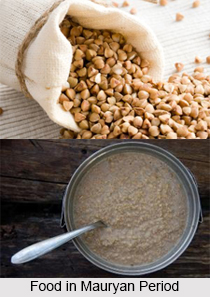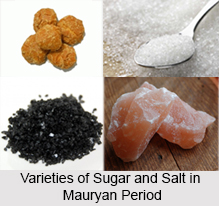 Food in Mauryan Period largely depended on two seasons. While the winter season included rice and millet which formed a major part of the Maurya Empire, the summer season included wheat and barley. Along with this Kautilya mentions that there was a third crop that was cultivated between these two seasons. This included "Munga" and "Masa". With new crops it added to the stock of crops grown in Indian agriculture along with new food items. Overall this period too followed the same style of food habits which included cereals, pulses, dairy products, meat and beverages.
Food in Mauryan Period largely depended on two seasons. While the winter season included rice and millet which formed a major part of the Maurya Empire, the summer season included wheat and barley. Along with this Kautilya mentions that there was a third crop that was cultivated between these two seasons. This included "Munga" and "Masa". With new crops it added to the stock of crops grown in Indian agriculture along with new food items. Overall this period too followed the same style of food habits which included cereals, pulses, dairy products, meat and beverages.
Several Food Preparations of Mauryan Period
Food in Mauryan Period differed from its predecessors in a very limited way when it introduced some more types of cereals which were popularly cultivated in ancient Mauryan Empire. In case of Rice along with the old varieties of rice namely Vrihi, Sali, Kodrava and Priyamgu, 2 new varieties of rice namely "Draka" and "Varaka" was introduced. Similarly 2 kinds of Barley was also introduce among which one was cultivated while the other was not cultivated but commonly used in preparing a mess, a gruel, groats and cakes. While Gruel was prepared with an inferior food grains; Groats were eaten with curds. Wheat occupied a more vital place among the cereals than in the previous period, it being invariably mentioned with barley. Besides the old pulses, pea was indeed popular. Soup was indeed popular and known a Patanjali.
Food in Mauryan Period further included large variety of dairy products. Besides cow"s milk, milk of buffaloes, sheep and goat was also used. The Maurya Empire was equally habituated in taking meat products as Arthashastra lays down specific role of the Superintendent of Slaughter Houses. Along with meat, fresh fishes were taken as well as sweet of Maurya Empire included honey and product of Sugarcane which further included juice of sugarcane, guda, raw sugar, sugar-candy and refined sugar which were amiably popular.
Food in Mauryan Period was largely prepared with salt and spices that include normal salt, rock salt, sea salt, bida salt and nitre along with the spices like long-pepper, ginger, cumin seeds, white mustard and corianders, cloves and turmeric. This further included 4 types of cardamom which are white, reddish white, short and black which was produced in India during that time.
Beverages in Mauryan Period
Along with other fruits and beverages, the Maurya Empire included a variety of beverages with great variety of intoxicating liquors. Kautilya lays down the responsibility of the Superintendent of Liquor which shows the popularity of the liquor in Maurya Empire. Along with this Megasthenes mentions that Indians used to take liquor during the festivals. Among the common drinks the wines and rice beers were in common use along with butter milk, grape juice, fruit juices and syrups that was consumed extensively in the Maurya Empire.
Cooking Methods in Mauryan Period
Thus, food in Maurya Period basically followed the same style of cooking. The only difference is that cooking was done in a more polished way.
Related Articles
History of Indian Food
Food in Ancient India
Indian Food
Maurya Empire
Beverages in Mauryan Empire
Arthashastra




















